As difficult as it may be to believe, the plants in your garden or the animals you release could have devastating consequences. Experts estimate an average cost of $120 billion in damages yearly in the United States, resulting directly from invasive species.
Learning how to identify invasive species in your area can help save the local ecosystem and wildlife. In this article, we’ll cover twelve invasive species in Massachusetts to be on the lookout for.
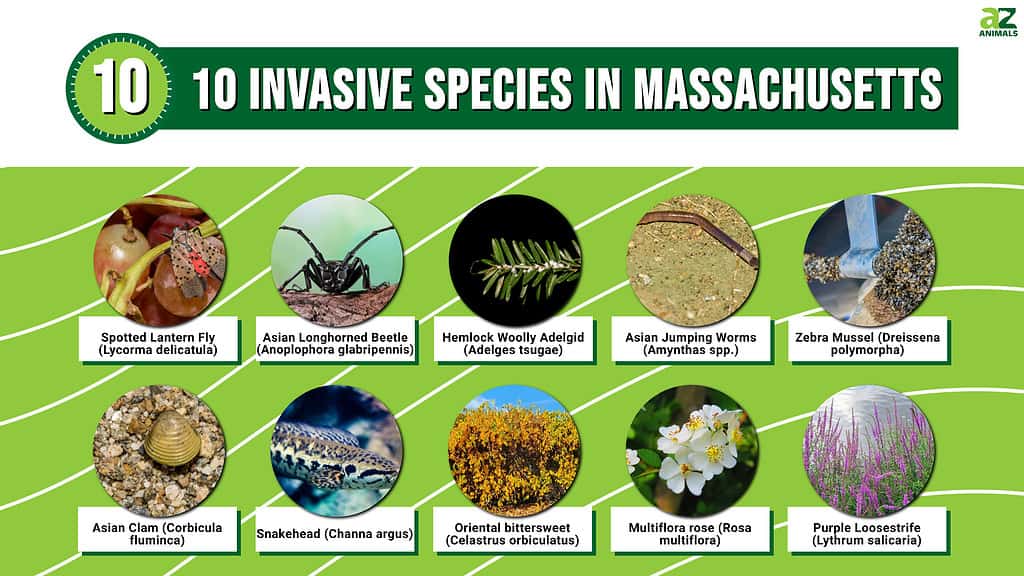
1. Spotted Lantern Fly (Lycorma delicatula)
The spotted lantern fly (Lycorma delicatula) is an ongoing problem in the Northern states. This insect looks different throughout its life cycle, presenting as an oozing mass on the side of plants in egg form and showing off beautiful polka-dotted wings in brown, black, and orange at maturation.
Accidentally imported from China, the spotted lantern fly wreaks havoc on crops with a particular fondness for fruit trees and grape vines. The USDA has released Smash and Scrape cards to help people identify and destroy these pests in Massachusetts and the Northeastern states.
Canadian officials ask campers and hikers traveling from Massachusetts across the border to check for spotted lantern flies on their equipment. Despite Massachusetts’s closeness to the Northern nation, these pests haven’t yet established themselves in Canada. However, spotted lantern flies are known as “hitchhikers” and often stick to camping gear and vehicles.
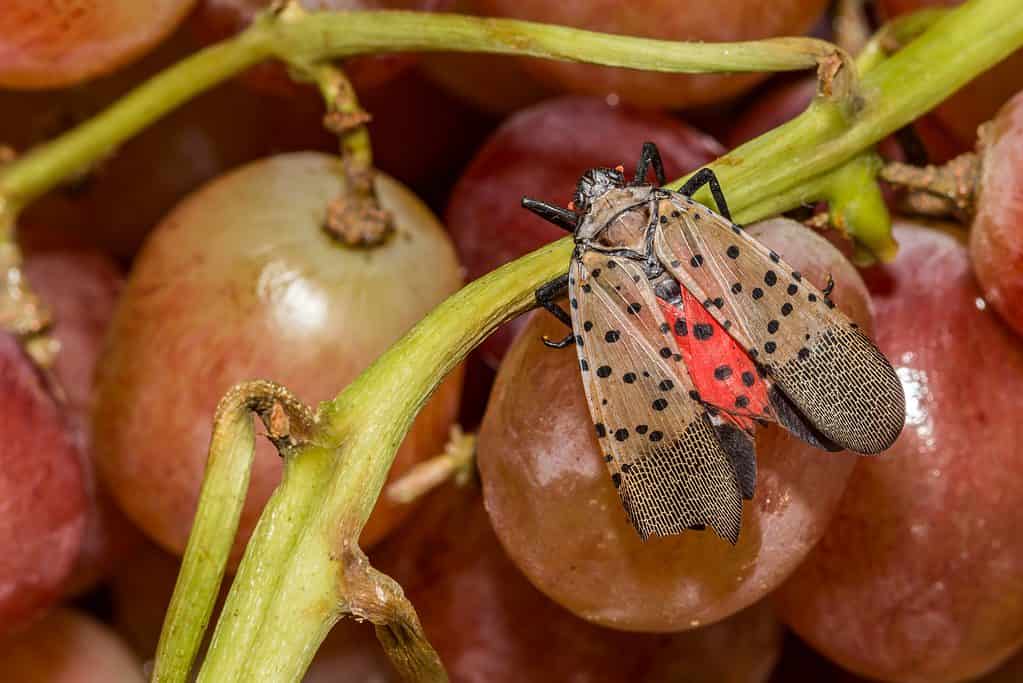
The spotted lantern is one of the most invasive species in Massachusetts.
©Jay Ondreicka/Shutterstock.com
2. Asian Longhorned Beetle (Anoplophora glabripennis)
The Asian Longhorned Beetle (Anoplophora glabripennis) has been causing chaos in the Northeastern states since the late 1990s. Native to Korea, it wasn’t discovered in Massachusetts until 2008.
The battle against the Asian Longhorned Beetle is ongoing in Massachusetts, with 110 square miles of forest quarantined off to limit the spread. This invasive pest is recognizable by its black, shiny body with white spots. Its body is approximately an inch long or more with its lengthy antennae.
This hungry beetle has a penchant for hardwood trees, often eating down to the heartwood and decimating entire forests. They also carry Dutch elm disease, exacerbating an already significant problem. Contact the local natural resources authority if you notice round holes or burrow marks, often paired with yellow leaves.

The Asian longhorn beetle is one of the most invasive beetle species in the world.
©Kurit afshen/Shutterstock.com
3. Hemlock Woolly Adelgid (Adelges tsugae)
At a glance, the hemlock woolly adelgid looks like mold or fungal growth. However, this invasive species is an insect related to the aphid. Native to Japan, experts believe these invasive pests were introduced through shipping in the 1980s.
These hungry pests are fond of hemlocks and have weakened and destroyed entire forests over time. This damage also impacts local fauna, which relies on hemlocks for shelter and food.
The easiest way to identify hemlock woolly adelgids is to look for soft egg sacs along the branches of a hemlock tree. These are often paired with yellow foliage.
Scientists are looking at several avenues to eliminate the hemlock woolly adelgid in Massachusetts, including the release of ladybird beetle and chemical interventions. If you spot these pests, photograph them and report them.
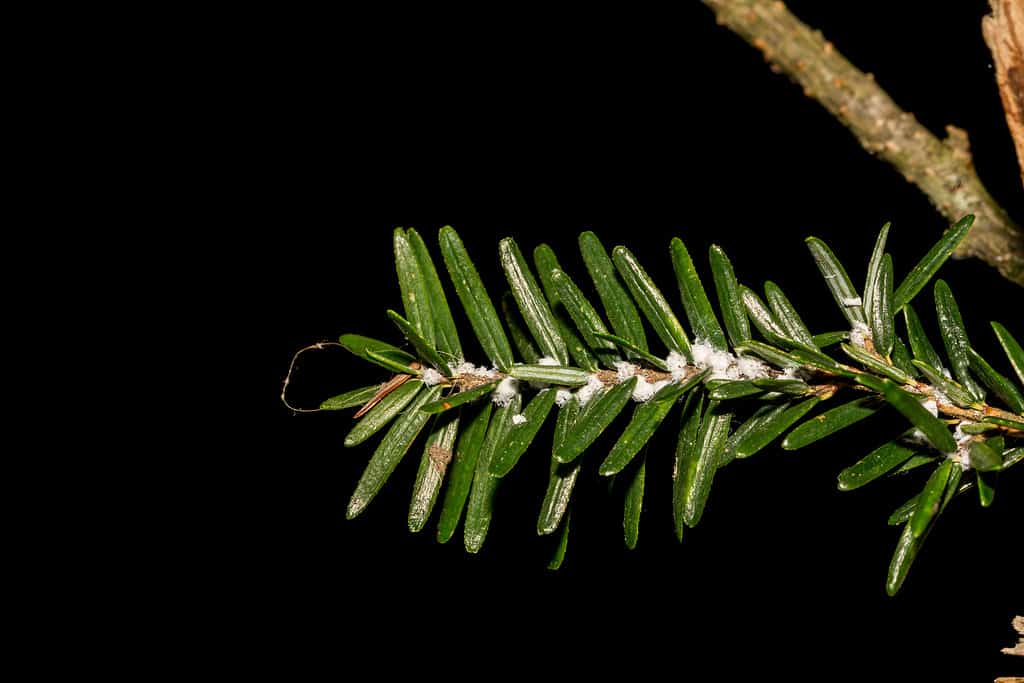
A close-up of Hemlock Woolly Adelgid Infestation in New England.
©iStock.com/JasonOndreicka
4. Asian Jumping Worms (Amynthas spp.)
While the Asian jumping worm is present in many of the Northern states, it’s become of particular concern in Andover, Massachusetts.
Colloquially called “the earthworm’s evil twin,” you can tell the difference between these invasive pests by their white clitellum (the band around its body), glossy appearance, and unusual hyperactivity. European earthworms have a browner clitellum that forms a complete circle.
While European earthworms are also non-native to North America, they contribute positively to the environment. When earthworms eat and excrete soil, they leave it rich with nutrients. Asian jumping worms derive nutrients from the soil of nutrients and negatively impact the surrounding flora.
Asian jumping worms are from Southern Asia. Experts believe they arrived via shipping imports and attribute their spread to bait sales and attempts at organic gardening.
The officials of the Town of Andover recommend pouring a blend of mustard and water onto the soil to draw out any worms. Then, assess the activity and color to determine if they are jumping worms. If so, remove them and destroy them.

Asian jumping worms can grow twice as fast as other worms and are an invasive species in Massachusetts.
©iStock.com/Arrlxx
5. Zebra Mussel (Dreissena polymorpha)
Zebra mussels (Dreissena polymorpha) have been causing problems for centuries. These freshwater mollusks are the only type that can stick to objects, and they do so in clusters. Experts believe these predatory bivalves invaded from Eastern Europe via cargo routes.
These pesky mollusks get their name from their brown and white striped pattern. Thanks to their quick reproduction and clustering habits, they present an enormous risk to freshwater environments.
Efficient filter feeders, these hungry pests can drain the local ecosystem of its phytoplankton, eating the main food source from native aquatic species. They also stir up the bottom of the lake or river and impact the local plant life.
Zebra mussels also negatively impact human populations. They’ll often cluster in pipes and streams, causing blockages and immense damage to water filters and treatment systems. Some areas report less tourism due to the strong odor on local beaches.
If you spot zebra mussels, remove them from the water and contact local natural resources authorities. Do not transport them from one body of water to another.
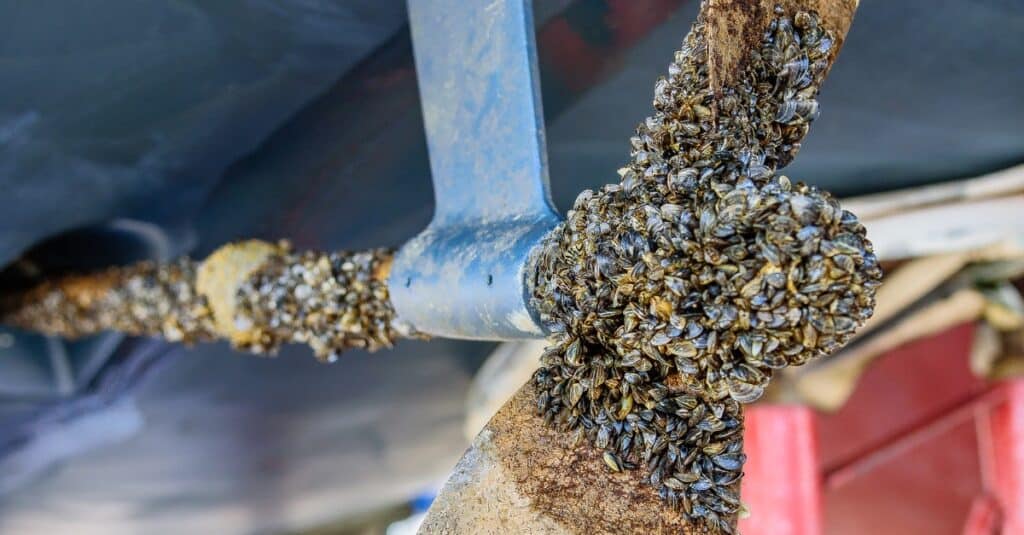
This is a bronze, two-blade propeller on a stainless steel shaft on a 36-foot sailboat covered in zebra mussels.
©iStock.com/JeffCaughey
6. Asian Clam (Corbicula fluminca)
The Asian Clam (Corbicula fluminca) is unfortunately well established in Massachusetts. First introduced to the West Coast from Southeast Asia in the 1930s, this invasive species has since spread and invaded many major waterways nationwide.
These small clams measure no more than 1.5 inches and have light brown shells with hints of green. As these creatures self-fertilize, getting them under control is difficult once they’ve started spreading.
Like zebra mussels, Asian clams are known for blocking pipes, infiltrating local water systems, and even damaging boats and other aquatic implements.
Similarly, the Asian clams form large clusters, sometimes with more than 6000 clams. They decimate local phytoplankton, putting stress on native aquatic flora and fauna to the point of extinction.
The only way to safely remove Asian clams from rivers and lakes is through intense manual scraping and elimination. Factories often use water temperature changes or chemicals to get rid of them. Natural resource experts advise that prevention is key when dealing with Asian clams.

The Asian clam is a well-established invasive species in Massachusetts.
©Jay Ondreicka/Shutterstock.com
7. Snakehead (Channa argus)
A Canton fisherman made waves in 2021 when he caught a snakehead (Channa argus) — a large fish native to Asia. This predatory fish can grow up to three feet long with brown mottled flesh and a sharp fin and teeth.
While the snakehead issue is under control, Massachusetts natural resource officers encourage help and attention from locals and visitors. The goal is to proactively prevent establishment. Snakeheads are established in Maryland and have decimated local fish populations to the point where visitors and anglers are offered a bounty for their capture.
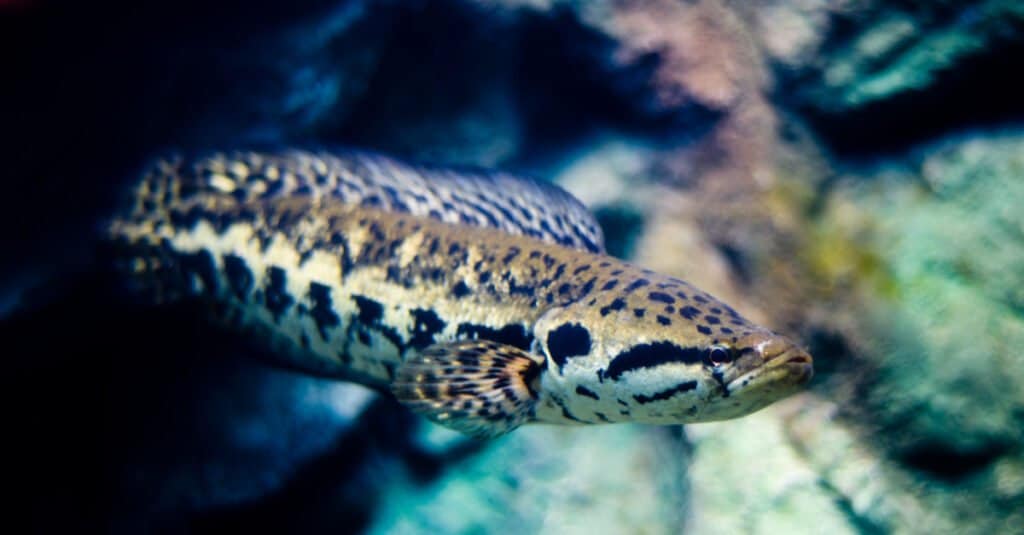
Snakehead fish have taken over rivers and lakes in Maryland. Massachusetts is working to avoid this fate.
©Narongchut/Shutterstock.com
8. Oriental bittersweet (Celastrus orbiculatus)
Oriental bittersweet (Celastrus orbiculatus) is a beautiful vining plant. It was historically used for decorative purposes. Its berries are similar to holly, making it a prime choice for holiday wreaths and decor — a choice that contributes to its invasive status.
In 2009, the state of Massachusetts banned the growth, importation, sale, and trade of Oriental bittersweet. These vining plants will wrap around trees to reach the sun, cutting off their vascular system and inhibiting the flow of nutrients.
The problem is exacerbated during the holiday season when birds will pluck the berries from outdoor decor and drop the seeds throughout the state.
According to the Town of Groton Massachusetts Invasive Species Committee, safe herbicide application requires expertise beyond the scope of most gardeners. Cutting can help reduce the spread, but root removal is the only surefire way to eliminate the problem.
If you love the look of Oriental bittersweet, experts recommend growing winter holly, American bittersweet, or Virginia creeper instead.
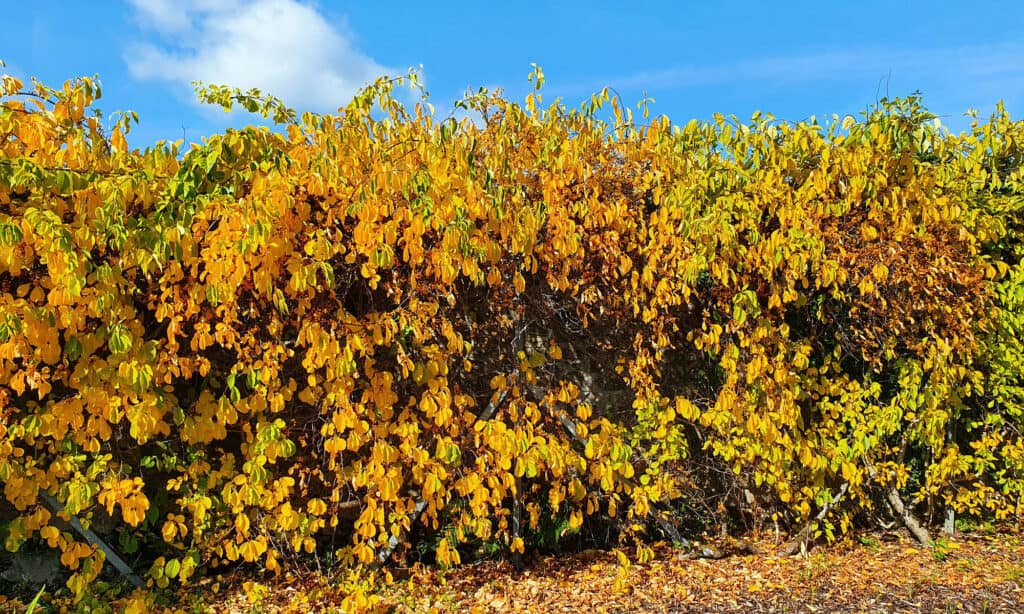
This beautiful vining plant cuts off the nutrients of trees as it reaches for the sun.
©iStock.com/TonyBaggett
9. Multiflora rose (Rosa multiflora)
Multiflora roses (Rosa multiflora) may look like a naturally-occurring wild rose, but they’re not. This invasive species is from Japan, China, and Korea.
This natural spreader will grow rapidly, overtaking other plants and harming local flora. It’s particularly fond of wetlands and coastal areas and could negatively impact the nesting grounds of native wetland creatures.
Intentionally brought to North America as an ornamental plant, experts now recommend getting rid of it, and its sister rose, Rosa rugosa. Instead, plant a native rose like the Virginia Rose (Rosa virginiana) or Carolina Rose (Rosa carolina).
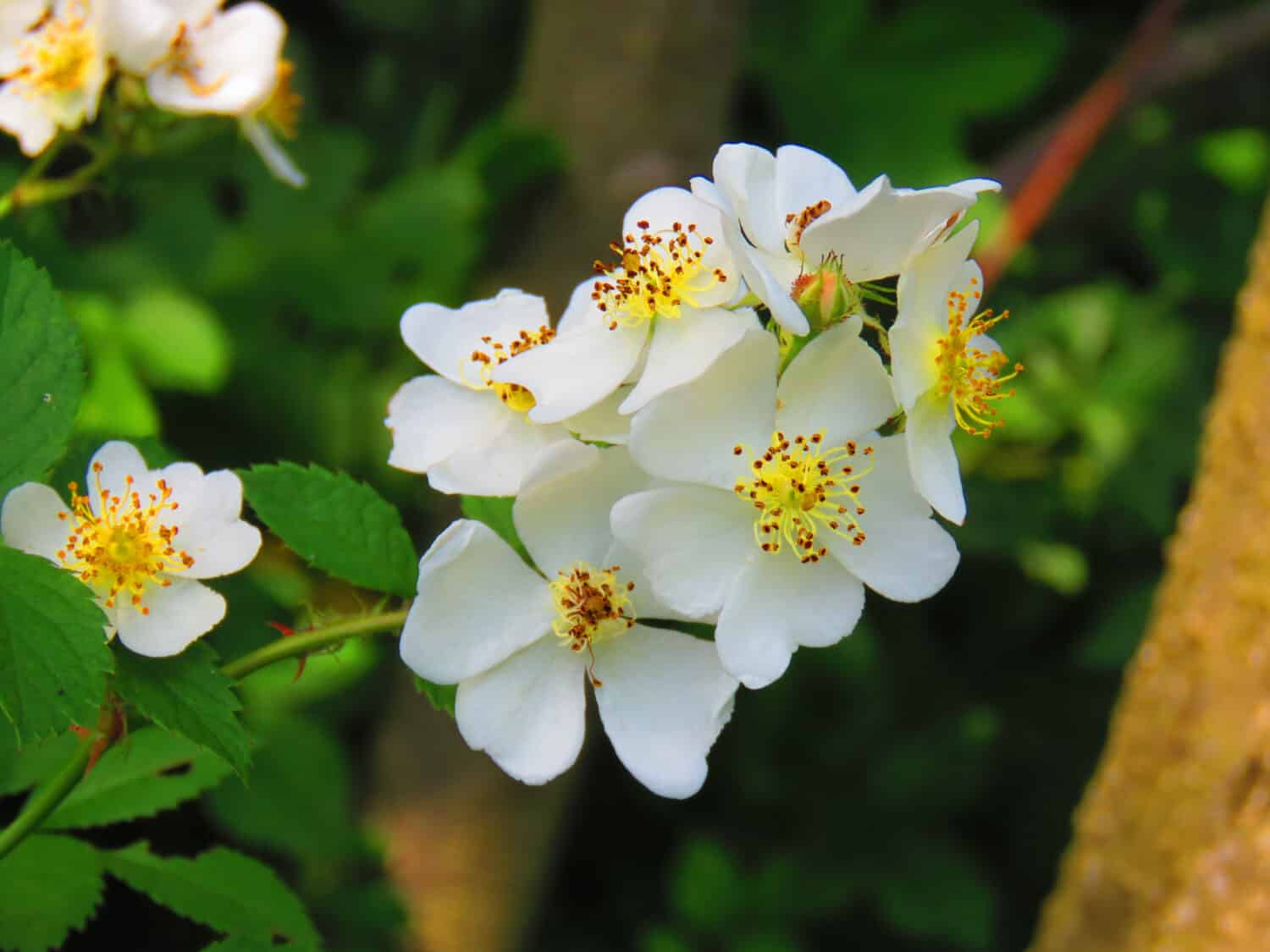
is beautiful but causes havoc to local ecosystems.
©Przemyslaw Muszynski/Shutterstock.com
10. Purple Loosestrife (Lythrum salicaria)
Purple loosestrife (Lythrum salicaria) is another beautiful yet harmful plant in Massachusetts. With lovely purple petals growing on tall, swaying stalks, purple loosestrife is wreaking havoc on local rivers, lakes, ponds, and wetlands.
This rapid reproducer can spread up to three million seeds per year! They often eradicate local flora while offering no nutrient value to local fauna. Purple loosestrife also loves the water and will spread into waterways, disrupting the flow.
Purple loosestrife is deeply rooted and incredibly labor-intensive to pull. Experts recommend reporting known infestations to avoid potential transference to other areas.
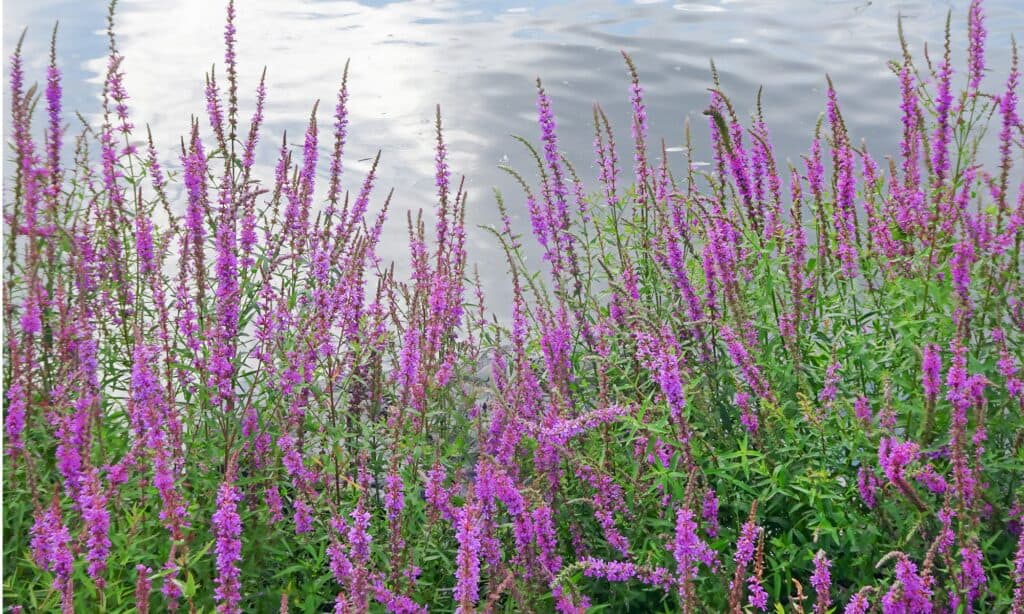
is an invasive species in Massachusetts that’s disrupting local ponds, lakes, and rivers.
©iStock.com/Natalia Kazarina
11. Garlic Mustard (Alliaria petiolata)
While the name seems harmless (and slightly appetizing), garlic mustard (Alliaria petiolata) is destroying local woodland flora in Massachusetts. This plant loves the shade and spreads rapidly through the forest, depriving local flora of sunlight and nutrients.
Garlic mustard has natural allelopathic mechanisms that limit the reproduction of other plants in the area via the release of chemicals. Native to Europe, it’s believed this plant was introduced for medicinal and food purposes.
Experts recommend pulling garlic mustard out at the roots whenever possible or cutting back stems to interrupt the natural seeding process.

Garlic mustard derives nutrients from other plants and slows their growth.
©Martin Fowler/Shutterstock.com
Summary of 11 Invasive Species in Massachusetts
| Invasive Species | Classification | Origin | |
|---|---|---|---|
| 1 | Spotted Lantern Fly (Lycorma delicatula) | Insect | China |
| 2 | Asian Longhorned Beetle (Anoplophora glabripennis) | Insect | Korea |
| 3 | Hemlock Woolly Adelgid (Adelges tsugae) | Insect | Japan |
| 4 | Asian Jumping Worms (Amynthas spp.) | Annelida | Southern Asia |
| 5 | Zebra Mussel (Dreissena polymorpha) | Mollusk | Europe |
| 6 | Asian Clam (Corbicula fluminca) | Mollusk | Asia |
| 7 | Snakehead (Channa argus) | Fish | Asia |
| 8 | Oriental bittersweet (Celastrus orbiculatus) | Flowering Plant | Asia |
| 9 | Multiflora rose (Rosa multiflora) | Flowering Plant | Japan |
| 10 | Purple Loosestrife (Lythrum salicaria) | Flowering Plant | Europe/Asia |
| 11 | Garlic Mustard (Alliaria petiolata) | Flowering Plant | Europe |
The photo featured at the top of this post is © vm2002/Shutterstock.com
Thank you for reading! Have some feedback for us? Contact the AZ Animals editorial team.






